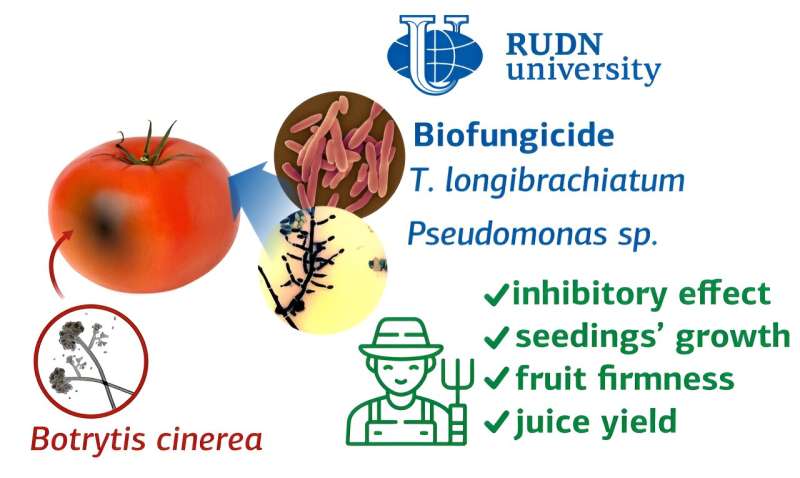This article has been reviewed according to Science X's editorial process and policies. Editors have highlighted the following attributes while ensuring the content's credibility:
fact-checked
proofread
Agronomists find microbes to protect tomatoes from dangerous fungus
![Effect of T. longibrachiatum (a) and Pseudomonas sp. (b) filtrates at various concentrations (C1: 20%; C2: 40%; C3: 60%; C4: 80%) on the mycelial growth (mm) of Botrytis cinerea at six incubation times (1 [D1], 2 [D2], 3 [D3], 5 [D5], 6 [D6], and 8 [D8] days) under laboratory conditions. The letters above the bars indicate significant differences between treatments within the experiments (p ≤ 0.5) according to Duncan’s multiple range tests. Data are the average of nine Petri dishes per replicate (with three replicates). Credit: Agronomy (2023). DOI: 10.3390/agronomy13071774 Agronomists find microbes to protect tomatoes from dangerous fungus](https://scx1.b-cdn.net/csz/news/800a/2023/agronomists-find-micro-1.jpg)
RUDN University agronomists and colleagues from Tunisia have discovered a way to stop the spread of a phytopathogenic fungus Botrytis cinerea. It affects crops, especially tomatoes. The Trichoderma fungus and the Pseudomonas bacterium can protect the crop from this pathogen. The results have been published in the journal Agronomy.
Botrytis cinerea is a gray mold that affects many plants. It is dangerous for strawberries, grapes, onions, and tomatoes. Fungicides are the usual way to combat phytopathogens. However, antifungal substances are dangerous to humans and the environment. In addition, the fungus becomes resistant to these drugs over time. The preferred alternative is biological control methods. RUDN University agronomists and colleagues from Tunisia proposed using other microbes to fight the pathogen: the Trichoderma fungus and bacteria from the Pseudomonas genus.
"For several decades, chemical fungicides have been the most common method of controlling botrytis cinerea. However, this pathogenic fungus has developed resistance to several fungicides. In addition, toxic residues in tomato fruit and soil threaten human health, the soil, and the environment. Biological methods should replace chemical ones to reduce the incidence of gray mold," said Rebouh Nazih, Ph.D., Associate Professor of the Department of Environmental Management of RUDN University.

Agronomists tested the effect of Trichoderma and Pseudomonas in vitro (in a Petri dish) and in vivo (on seeds and fruits of infected tomato). The authors monitored the amount of secondary metabolites—compounds produced by microorganisms during their life processes—and also measured the reproduction rate of the pathogenic fungus.
Both microbes have proven useful in controlling botrytis. Trichoderma can produce the enzymes chitinase, protease, and gluconase, while pseudomonas can produce catalase and amylase. All these secondary metabolites help suppress the growth of botrytis gray. At a concentration of 40%, the spread rate of the fungus decreased by half.
"Beneficial microorganisms—bacteria and fungi—can become biological control agents and biostimulants for the growth and productivity of crops. Trichoderma cultures and pseudomonads slow down the growth of botrytis cinerea, which attacks tomato plants. Antifungal activity is due mainly to the antibiotic activity of secondary metabolites. Our results provide insight into the mechanisms of action of biological control agents," said Rebouh Nazih, Ph.D., associate professor of the Department of Environmental Management of RUDN University.
More information: Lobna Hajji-Hedfi et al, Understanding the Influence of Applying Two Culture Filtrates to Control Gray Mold Disease (Botrytis cinerea) in Tomato, Agronomy (2023). DOI: 10.3390/agronomy13071774
Provided by Russian Foundation for Basic Research





















